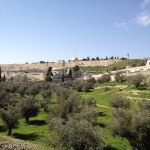
Today was a busy day in Jerusalem.
We left Yad Hashemona for Jerusalem at 8:15 a.m. and returned at 6:30 p.m.
Here’s what we did in the morning: Mount Scopus, Mount of Olives, Kidron Valley, Garden of Gethsemane, Memorial of Absalom, Tomb of Zecharia, and lunch at Ramat Rachel kibbutz.
After lunch we drove to the House of Caiaphas (site of Jesus’ trial) and the place of Peter’s denial of Jesus. The rest of the afternoon was a walking tour to the following places: coffee at Aroma @ Jaffa Gate, Jaffa Gate, Tower of Herod’s Palace, Armenian Quarter (Old City), Jewish Quarter (Old City), Western Wall, Via Dolorosa (toward Ecce Homo), Ecce Homo (site of Antonia Fortress where Jesus faced Pontius Pilate) , Via Dolorosa (toward Church of Holy Sepulchre), Muslim Quarter (Old City), Ethiopian entry to Church of the Holy Sepulchre, Church of the Holy Sepulchre (Sword of Godfrey de Bouillon), Jaffa Gate.
A typical tour group might have visited the Mount of Olives, the Western Wall and the Church of the Holy Sepulchre in a day. But we are only eight, we moved quickly, and were led by an energetic 65 year-old who knew exactly where he was going, what he wanted us to see and why he wanted us to see it.
Arie carries maps, lots of maps, that he can unfurl at any time to explain the physical context of where we are. From time-to-time he would quiz us about our orientation in the city, asking us which way is north, or which way is Mount Zion or Mount Moriah. The emphasis is on learning, not entertainment, though I can’t think of having experienced a more entertaining day.
The typical tour group would come away from Jerusalem able to say they had seen the sights. We came away from our day in Jerusalem being able to say that and more.
For example, we can now say we know why Jesus left Jerusalem each evening to meet with His disciples at the Mount of Olives, why it would have been such a shock for Jesus’ disciples when Jesus told them not to go to Jerusalem when they saw the city surrounded, why the Pharisees called Jesus a “Samaritan devil” and who the good samaritan in the parable represented, where Jesus took His disciples (though not mentioned in the text) at the end of John 14 and why the Roman soldiers dressed Jesus up like a king and mocked him.
These are just a few examples, but you get the point. We didn’t just take away memories; we took away understanding. It will be easier now for us to digest the events and statements in the Bible because “…knowledge is easy to one who has understanding.” (Proverbs 14:6).
Today we studied what Jesus did in Jerusalem during the last week of his earthly ministry. Tomorrow we head to Galilee, where Jesus lived. GS
